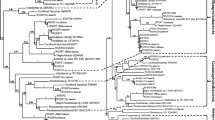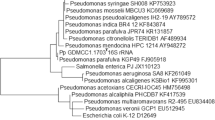Abstract
Catechol 1, 2-dioxygenase (1, 2-CTD) plays an important role in the biodegradation of most aromatic pollutants (e.g. phenol) by cleaving the bond between the phenolic hydroxyl groups. In this study, we analysed microbial populations in petroleum-contaminated soil samples by the culture-dependent approach and chose one population as a sample location for metagenomic studies. This population showed the largest number of phenol-degrading isolates and the most phylogenetic diversity based on repetitive sequence-based PCR and 16S rDNA analyses. The isolates were assigned mainly to the bacterial genera Acinetobacter and Pseudomonas. To enable maximum recovery of 1, 2-CTD coding sequence from the genomic pool of bacterial populations, we extracted the substrate-induced RNA, reverse-transcribed it to the specific cDNA using primers designed for this purpose and constructed a metagenomic library. Alignment analysis of one recombinant sequence indicated a significant divergence, with the 1, 2-CTD gene of Pseudomonas aeruginosa DK2 as the closest species according to sequence similarity. This result indicates that such specifically designed primers are likely suitable candidates as biomarkers to construct 1, 2-CTD gene-targeted metagenomic libraries. By sequencing the larger clones of this metagenomic library, we hope to obtain novel and unpredicted 1, 2-CTD genes that can contribute to our knowledge of microbial diversity of these genes.








Similar content being viewed by others
References
Bagneris C, Cammack R, Mason R (2005) Subtle difference between benzene and toluene dioxygenases of Pseudomonas putida. Appl Environ Microbiol 71:1570–1580
Boone DR, Castenholz RW, Garrity GM, Brenner DJ, Krieg NR, Staley JT (2005) Bergey's manual of systematic bacteriology. Springer Science & Business Media, New York
Brennerova M, Josefiova J, Brenner V, Pieper D (2009) Metagenomics reveals diversity and abundance of meta-cleavage pathways in microbial communities from soil highly contaminated with jet fuel under air-sparging bioremediation. Environ Microbiol 11:2216–2227
Chen Y, Liu H, Chen H (2003) Characterization of phenol biodegradation by Comamonas testosteroni zd4-1 and Pseudomonas aeruginosa zd4-3. Biomed Environ Sci 16:163–172
Committee on Metagenomics: Challenges and Functional Applications (2007) The new science of metagenomics: revealing the secrets of our microbial planet, 1st edn. National Academies Press, Washington D.C.
Cowan D, Stafford W (2007) Metagenomic methods for the identification of active micro-organisms and genes in biodegradation processes. Univ West Cape Res Repository 3:1–19
Daniel R (2004) The soil metagenome: a rich resource for the discovery of novel natural products. Curr Opin Biotechnol 15:199–204
Daniel R (2005) The metagenomics of soil. Nat Rev Microbiol 3:470–478
Delmont T, Clark I, Simonet P, Vogel T (2011a) Metagenomic comparison of direct and indirect soil DNA extraction approaches. J Microbiol Methods 86:397–400
Delmont T, Robe P, Cecillon S, Clark I, Constancias F (2011b) Accessing the soil metagenome for studies of microbial diversity. Appl Environ Microbiol 77:1315–1324
Enan R (2006) Isolation and molecular characterization of phenol degrading Gram-positive bacteria from oil contaminated soil. Res J Microbiol 4:307–318
Eyers L, Schuler L, Stenuit B, Agathos N, Fantroussi S (2004) Environmental genomics: exploring the unmined richness of microbes to degrade xenobiotics. Appl Microbiol Biotechnol 66:123–130
Fernández-Arrojo L, Guazzaroni ME, López-Cortés N, Beloqui A, Ferrer M (2010) Metagenomic era for biocatalyst identification. Curr Opin Biotechnol 21:725–733
Folsom J, Richards L, Pitts B, Roe F, Ehrlich G, Parker A, Mazurie A, Stewart P (2010) Physiology of Pseudomonas aeruginosa in biofilms as revealed by transcriptome analysis. BMC Microbiol 10:294–301
Geng A, Soh A, Lim C, Loke L (2006) Isolation and characterization of phenol degrading bacterium from an industrial active sludge. Appl Microbiol Cell Physiol 71:728–735
Gibson D, Parales R (2000) Aromatic hydrocarbon dioxygenases in environmental biotechnology. Curr Opin Biotechnol 11:236–243
Giegerich R, Meyer F, Schleiermacher C (1996) GeneFisher software support for the detection of postulated genes. Proc Int Conf Intell Syst Mol Biol 4:68–77
Grimm A, Harwood C (1999) NahY a catabolic plasmid encoded receptor required for chemotaxis of Pseudomonas putida to the aromatic hydrocarbon naphthalene. J Bacteriol 181:3310–3316
Handelsman J, Rondon R, Brady F, Clardy J, Goodman R (1998) Molecular biological access to the chemistry of unknown soil microbes: a new frontier for natural products. Chem Biol 5:245–249
Heuer H, Krsek M, Baker P, Smalla K, Wellington M (1997) Analysis of actinomycete communities by specific amplification of genes encoding 16S rRNA and gel-electrophoretic separation in denaturing gradients. Appl Environ Microbiol 63:3233–3241
Hirsch R, Mauchline H, Clark M (2010) Culture independent molecular techniques for soil microbial ecology. Soil Biol Biochem 42:878–887
Hosokawa R, Nagai M, Morikawa M, Okuyama H (2009) Autochthonous bioaugmentation and its possible application to oil spills. World J Microbiol Biotechnol 25:1519–1528
Iwai S, Chai B, Sul W, Cole J, Hashsham J, Tiedje J (2010) Gene-targeted-metagenomics reveals extensive diversity of aromatic dioxygenase genes in the environment. ISME J 4:279–285
Iwai S, Chai B, Jesus E, Penton R, Lee T, Cole J, Tiedje J (2011) In: de Bruijn FJ (ed) Handbook of molecular microbial ecology 1: metagenomics and complementary approaches. Wiley Blackwell, Hoboken, pp 235–243
Jiang L, Ruan Q, Li R, Li T (2013) Biodegradation of phenol by using free and immobilized cells of Acinetobacter sp. BS8Y J Basic Microbiol 53(3):224–30
Jorgensen S (2008) Advances in monitoring of catabolic genes during bioremediation. Indian J Microbiol 48:152–155
Kakirde K, Parsley L, Liles M (2010) Size does matter: application-driven approaches for soil metagenomics. Soil Biol Biochem 42:1911–1923
Khara P, Roy M, Chakraborty J, Ghosal D, Dutta K (2014) Functional characterization of diverse ring-hydroxylating oxygenases and induction of complex aromatic catabolic gene clusters in Sphingobium sp. PNB. FEBS Open Biol 4:290–300
Kumar A, Kumar S, Kuma S (2005) Biodegradation kinetics of phenol and catechol using Pseudomonas putida MTCC 1194. Biochem Eng J 22:151–159
Liang R, Wu X, Dai Q, Jin D, Wang Y (2010) Genetic diversity of phthalic acid esters degrading bacteria isolated from different geographical regions of China. Antonie Van Leeuwenhoek 97:79–89
Linhart C, Shamir R (2005) The degenerate primer design problem: theory and applications. Bioinformatics 18:172–180
Lisek A, Sas Paszt L, Trzciński P (2014) Identification and assessment of genetic similarity of soil bacterial isolates of Pseudomonas spp. using molecular techniques. Pol J Microbiol 63(3):291–8
Lorenz P, Eck J (2005) Metagenomics and industrial applications. Nat Rev Microbiol 3:510–516
Louws FJ, Fulbright DW, Stephens CT, de Bruijn FJ (1994) Specific genomic fingerprints of phytopathogenic Xanthomonas and Pseudomonas pathovars and strains generated with repetitive sequences and PCR. Appl Environ Microbiol 60(7):2286–95
Malik S, Beer M, Megharaj M (2008) The use of molecular techniques to characterize the microbial communities in contaminated soil and water. Environ Int 34:265–276
Manickam N, Pathak A, Saini S, Mayilraj S, Shanker R (2010) Metabolic profiles and phylogenetic diversity of microbial communities from chlorinated pesticides contaminated sites of different geographical habitats of India. J Appl Microbiol 109:1458–1468
Mocali S, Bendetti A (2010) Exploring research frontiers in microbiology: the challenge of metagenomics in soil microbiology. Res Microbiol 161:497–505
Morimoto S, Fujii T (2009) A new approach to retrieve full lengths of functional genes from soil by PCR-DGGE and metagenome walking. Appl Microbiol Biotechnol 83:389–396
Mrozik A, Piotrowska-Seget Z (2010) Bioaugmentation as a strategy for cleaning up of soils contaminated with aromatic compounds. Microbiol Res 165:363–375
Newton CR, Graham A (1996) PCR: introduction to biotechniques. 2nd edn. Bios Scientific Publishers, Milton Park
Parales E, Lee K, Resnick S, Jiang H, Lessner D, Gibson D (2000) Substrate specificity of naphthalene dioxygenase: effect of specific amino acids at the active site of the enzyme. J Bacteriol 182:1641–1649
Prakash T, Taylor T (2012) Functional assignment of metagenomic data: challenges and applications. Brief Bioinform 10:1–17
Rondon M, August P, Bettermann A, Brady S (2000) Cloning the soil metagenome: a strategy for accessing the genetic and functional diversity of uncultured microorganisms. Appl Environ Microbiol 6:2541–2547
Sambrook J, Russel D (2001) Molecular cloning. 3rd edn. Cold Spring Harbor Laboratory Press, New York
SantaLucia J (1998) A unified view of polymer, dumbbell, and oligonucleotide DNA nearest-neighbor thermodynamics. Proc Natl Acad Sci USA 95:1460–1465
Sei K, Asano K, Tateishi N, Mori K, Ike M, Fujita M (1999) Design of PCR primers and gene probes for the general detection of bacterial populations capable of degrading aromatic compounds via catechol cleavage pathways". J Biosci Bioeng 88:542–550
Silva C, Hayden H, Sawbridge T, Mele P, Paula S, Silva L, Vidigal P, Vicentini R, Sousa M, Torres A, Santiago M, Oliveira V (2013) Identification of genes and pathways related to phenol degradation in metagenomic libraries from petroleum refinery wastewater. PLoS One 4:1–11
Steele L, Streit R (2005) Metagenomics: advances in ecology and biotechnology. FEMS Microbiol Lett 247:105–111
Stenuit B, Eyers L, Schuler L, Agathos S, George I (2008) Emerging high-throughput approaches to analyse bioremediation of sites contaminated with hazardous and/or recalcitrant wastes. Biotechnol Adv 26:561–575
Suenaga H, Watanabe T, Sato M, Furukawa K (2002) Alteration of regiospecificity in biphenyl dioxygenase by active-site engineering. J Bacteriol 184:3682–3688
Suenaga H, Mizuta S, Miyazaki K, Yaoi K (2014) Diversity of extradiol dioxygenases in aromatic-degrading microbial community explored using both culture-dependent and culture-independent approaches. FEMS Microbiol Ecol 90(2014):367–379
Tamura K, Peterson D, Peterson N, Stecher G, Nei M, and Kumar S (2011) MEGA5: Molecular Evolutionary Genetics Analysis using maximum likelihood, evolutionary distance, and maximum parsimony methods. Mol Biol Evol 28:2731–2739
Tancsics A, Szoboszlay S, Kriszt B, Kukolya J, Baka E, Marialigeti K, Revesz S (2008) Applicability of the functional gene catechol 1 2-dioxygenase as a biomarker in the detection of BTEX-degrading Rhodococcus species. J Appl Microbiol 105:1026–1033
Uhlik O, Jecna K, Leigh M, Mackova M, Macek T (2009) DNA based stable isotope probing: a link between community structure and function. Sci Total Environ 407:3611–3619
Vardar G, Wood K (2005) Protein engineering of toluene-o-xylene monooxygenase from Pseudomonas stutzeri OX1 for enhanced chlorinated ethene degradation and o-xylene oxidation. Appl Microbiol Biotechnol 68:510–517
Warnecke F, Hugenholtz P (2007) Building on basic metagenomics with complementary technologies. Genome Biol 8:231
Watanabe K, Teramoto M, Futamata H, Harayama S (1998) Molecular detection isolation and physiological characterization of functionally dominant phenol-degrading bacteria in activated sludge. Appl Environ Microbiol 11:4396–4402
Webster R (2008) Soil sampling and methods of analysis - edited by M.R. Carter & E.G. Gregorich. Eur J Soil Sci 59:1010–1011. doi:10.1111/j.1365-2389.2008.01052_5.x
Witzig R, Junca H, Hecht J, Pieper D (2006) Assessment of toluene/biphenyl dioxygenase gene diversity in benzene-polluted soils: links between benzene biodegradation and genes similar to those encoding isopropylbenzene dioxygenases. Appl Environ Microbiol 72:3504–3514
Acknowledgments
The authors acknowledge VP Research, Alzahra University for funding of this research.
Author information
Authors and Affiliations
Corresponding author
Ethics declarations
Conflict of interest
The authors declare that no conflict of interest exists.
Rights and permissions
About this article
Cite this article
Nafian, F., Gharavi, S. & Soudi, M.R. Degenerate primers as biomarker for gene-targeted metagenomics of the catechol 1, 2-dioxygenase-encoding gene in microbial populations of petroleum-contaminated environments. Ann Microbiol 66, 1127–1136 (2016). https://doi.org/10.1007/s13213-016-1197-3
Received:
Accepted:
Published:
Issue Date:
DOI: https://doi.org/10.1007/s13213-016-1197-3




